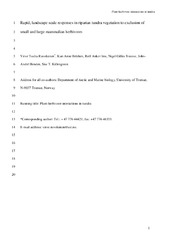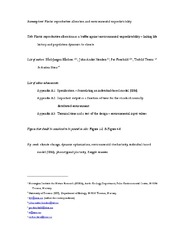Artikler, rapporter og annet (arktisk og marin biologi): Recent submissions
Now showing items 1561-1580 of 1643
-
Rapid, landscape scale responses in riparian tundra vegetation to exclusion of small and large mammalian herbivores
(Journal article; Tidsskriftartikkel; Peer reviewed, 2011)Productive tundra plant communities composed of a variety of fast growing herbaceous and woody plants are likely to attract mammalian herbivores. Such vegetation is likely to respond to different-sized herbivores more rapidly than currently acknowledged from the tundra. Accentuated by currently changing populations of arctic mammals there is a need to understand impacts of different-sized herbivores ... -
Plastic reproductive allocation as a buffer against environmental stochasticity : linking life history and population dynamics to climate
(Journal article; Tidsskriftartikkel; Peer reviewed, 2011)Empirical work suggest that long-lived organisms have adopted risk sensitive reproductive strategies where individuals trade the amount of resources spent on reproduction versus survival according to expected future environmental conditions. Earlier studies also suggest that climate affects population dynamics both directly by affecting population vital rates and indirectly through long-term changes ... -
Spawning behaviour of Arctic charr (Salvelinus alpinus) : risk of sperm competition and timing of milt release for sneaker and dominant males
(Journal article; Tidsskriftartikkel; Peer reviewed, 2011)A mismatch in timing between the release of male and female gametes in external fertilizers may lead to failed fertilization or, under sperm competition, reduced paternity. To quantify the actual synchrony of gamete release and the level of sperm competition we placed video cameras on two spawning grounds of a naturally spawning population of Arctic charr ( Salvelinus alpinus). Females release eggs ... -
Red fox takeover of arctic fox breeding den : an observation from Yamal Peninsula, Russia
(Journal article; Tidsskriftartikkel; Peer reviewed, 2011)Here, we report from the first direct observation of a red fox (Vulpes vulpes) intrusion on an arctic fox (Vulpes lagopus) breeding den from the southern Arctic tundra of Yamal Peninsula, Russia in 2007. At the same time, as a current range retraction of the original inhabitant of the circumpolar tundra zone the arctic fox is going on, the red fox is expanding their range from the south into arctic ... -
Shrub expansion in tundra ecosystems : dynamics, impacts and research priorities
(Journal article; Tidsskriftartikkel; Peer reviewed, 2011)Recent research using repeat photography, long-term ecological monitoring and dendrochronology has documented shrub expansion in arctic, high-latitude and alpine tundra ecosystems. Here, we (1) synthesize these findings, (2) present a conceptual framework that identifies mechanisms and constraints on shrub increase, (3) explore causes, feedbacks and implications of the increased shrub cover in tundra ... -
D. Whitmarsh: Economic management of marine living resources-A practical introduction. Earthscan, London, 2011, XV+171 pp., A 24.99 pound (Paperback), ISBN 978-1-84971-259-0
(Journal article; Tidsskriftartikkel; Peer reviewed, 2011) -
Seasonal and diel vertical migration of zooplankton in the High Arctic during the autumn midnight sun of 2008
(Journal article; Tidsskriftartikkel; Peer reviewed, 2011)The diel vertical migration (DVM) of Calanus (Calanus finmarchicus, Calanus glacialis and Calanus hyperboreus) and Metridia longa was investigated in August 2008 at six locations to the north and northwest of Svalbard (Rijpfjorden, Ice, Marginal Ice Zone, Shelf break, Shelf and Kongsfjorden). Despite midnight sun conditions, a diel light cycle was clearly observed at all stations. We collected data ... -
Intrapopulation variability shaping isotope discrimination and turnover : experimental evidence in Arctic Foxes
(Journal article; Tidsskriftartikkel; Peer reviewed, 2011)Tissue-specific stable isotope signatures can provide insights into the trophic ecology of consumers and their roles in food webs. Two parameters are central for making valid inferences based on stable isotopes, isotopic discrimination (difference in isotopic ratio between consumer and its diet) and turnover time (renewal process of molecules in a given tissue usually measured when half of the tissue ... -
The ghost of development past : the impact of economic security policies on Saami pastoral ecosystems
(Journal article; Tidsskriftartikkel; Peer reviewed, 2011)To ensure economic viability over time, any efforts to meet the Millennium Development Goals need to reconcile conservation with development interventions. Particularly, in marginal and risk prone areas erosion of resilience could make production systems more susceptible to environmental risks that compromise the economic security. By longitudinal analyses of long-term data records we investigated the ... -
Early life history of daubed shanny (Teleostei: Leptoclinus maculatus) in Svalbard waters
(Journal article; Tidsskriftartikkel; Peer reviewed, 2011)The daubed shanny (Leptoclinus maculatus, Family Stichaeidae) is considered to be an ecologically significant species in the arctic waters of Norway because of high abundance and the unique energy storage abilities of its postlarvae. Both postlarvae and adults are found in relative large abundances in Svalbard fjords as well as along the ice edge of north-east Svalbard, even at sub-zero temperatures. ... -
Growth and lipid class composition of the Arctic pelagic amphipod Themisto libellula
(Journal article; Tidsskriftartikkel; Peer reviewed, 2011)Carnivorous zooplankton is a key element to the energy transfer through the arctic food web, linking lipid rich herbivores to the top predators. We investigated the growth and lipid dynamic of the Arctic pelagic amphipod Themisto libellula in Kongsfjorden (Svalbard, 79°N) from May to October 2007. Additional samplings were performed in spring and summer 2006 and further north in Rijpfjorden (80°N), ... -
M. Speight and P. Henderson : book review : Marine ecology : concepts and applications.
(Journal article; Tidsskriftartikkel; Peer reviewed, 2011) -
G.M. Turchini, W.-K. Ng and D.R. Tocher (eds): book review : Fish oil replacement and alternative lipid sources in aquaculture feeds.
(Journal article; Tidsskriftartikkel; Peer reviewed, 2011) -
M.A. Pavlidis and C.C. Mylonas (eds): book review : Sparidae : biology and aquaculture of gilthead sea bream and other species
(Journal article; Tidsskriftartikkel; Peer reviewed, 2011) -
A.D. McIntyre (ed) : book review : Life in the world's oceans - diversity, distribution and abundance.
(Journal article; Tidsskriftartikkel; Peer reviewed, 2011) -
The adaptive significance of chromatophores in the Arctic under-ice amphipod Apherusa glacialis
(Journal article; Tidsskriftartikkel; Peer reviewed, 2011)Solar radiation is a crucial factor governing biological processes in polar habitats. Containing harmful ultraviolet radiation (UVR), it can pose a threat for organisms inhabiting surface waters of polar oceans. The present study investigated the physiological color change in the obligate sympagic amphipod Apherusa glacialis mediated by red-brown chromatophores, which cover the body and internal ... -
Seaward migrating Atlantic salmon smolts with low levels of gill Na+, K+ -ATPase activity : is sea entry delayed?
(Journal article; Tidsskriftartikkel; Peer reviewed, 2010-11-16)Two groups of migrating wild Atlantic salmon (Salmo salar) smolts caught within a 1 week interval in the River Alta, northern Norway, were tagged with acoustic transmitters and measured for gill Na+, K+ -ATPase activity in order to compare their smolt status with timing of sea entry. The first group of smolts had low levels of gill Na+, K+ -ATPase activity and resided in the lower part of the river ... -
The Nature Index : a general framework for synthesizing knowledge on the State of Biodiversity
(Journal article; Tidsskriftartikkel; Peer reviewed, 2011)The magnitude and urgency of the biodiversity crisis is widely recognized within scientific and political organizations. However, a lack of integrated measures for biodiversity has greatly constrained the national and international response to the biodiversity crisis. Thus, integrated biodiversity indexes will greatly facilitate information transfer from science toward other areas of human society. ... -
Winter quarters of wetland ground beetles (Coleoptera, Carabidae) in South Scandinavia
(Journal article; Tidsskriftartikkel; Peer reviewed, 2011)Sites at various distances from eutrophic and mesotrophic lakes and fens on the island Öland in southern Sweden were systematically surveyed in summer (May–August) and autumn (late September–October) to elucidate the hibernation sites of wetland carabid beetles. Thirty-five of 47 wetland species were found in their winter quarters. In areas ≤50 m from the lakes and fens, the observed as well as the ... -
Antihyperglycemic Effect of Ganoderma Lucidum Polysaccharides on Streptozotocin-Induced Diabetic Mice
(Journal article; Tidsskriftartikkel; Peer reviewed, 2011)The current study evaluated the glucose-lowering effect of ganoderma lucidum polysaccharides (Gl-PS) in streptozotocin (STZ)-induced diabetic mice. The diabetic mice were randomly divided into four groups (8 mice per group): diabetic control group, low-dose Gl-PS treated group (50 mg/kg, Gl-PS), high-dose Gl-PS treated group (150 mg/kg, Gl-PS) and positive drug control treated group (glibenclamide, ...


 English
English norsk
norsk


















